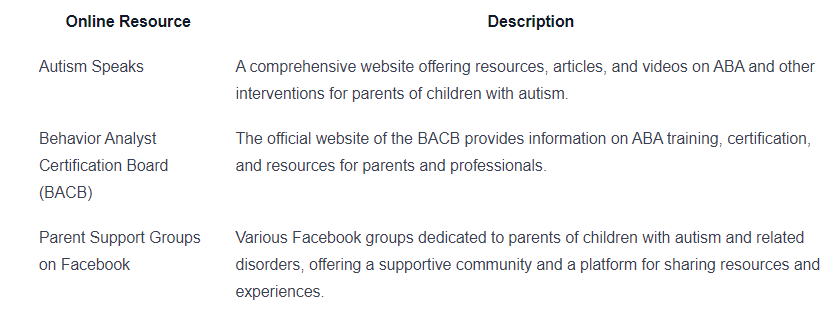ABA Training for Parents: All You Need to Know
Discover the power of ABA training for parents. From finding qualified therapists to creating a structured environment, all you need to know!


Understanding ABA Training
ABA training, or Applied Behavior Analysis training, is a structured and evidence-based approach to teaching skills and managing behaviors. It is commonly used to help individuals with autism spectrum disorder (ASD) develop new skills, reduce problem behaviors, and improve overall quality of life. ABA training can also be beneficial for parents, as it equips them with the knowledge and strategies needed to support their child's learning and behavior.
What is ABA Training?
ABA training is based on the principles of behavior analysis, which involve understanding how behaviors are influenced by the environment. It focuses on breaking down complex skills into smaller, manageable steps and using positive reinforcement to promote desired behaviors. ABA training can be implemented in various settings, including therapy centers, schools, and homes.
Through ABA training, parents learn how to identify and address their child's specific needs and challenges. They also gain practical skills in implementing behavior management techniques, teaching new skills, and promoting independence. ABA training often involves collaboration between parents and ABA therapists to ensure consistency and maximize the child's progress.
Importance of ABA Training for Parents
ABA training is highly valuable for parents of children with ASD, as it empowers them to actively participate in their child's development and well-being. Here are some key reasons why ABA training is important for parents:
- Increased Understanding: ABA training helps parents gain a deeper understanding of their child's behaviors, strengths, and challenges. This knowledge allows them to respond effectively to their child's needs, fostering a positive and supportive environment.
- Improved Communication: ABA training provides parents with effective communication strategies to engage and interact with their child. This can strengthen the parent-child bond and enhance overall communication skills.
- Behavior Management: ABA training equips parents with techniques to manage challenging behaviors and promote positive ones. It provides strategies for setting clear expectations, implementing consistent routines, and using reinforcement to encourage desired behaviors.
- Skill Development: ABA training helps parents facilitate skill development in areas such as communication, social interaction, self-help skills, and academics. By implementing ABA strategies at home, parents can support their child's progress and promote generalization of skills across different environments.
- Collaboration and Advocacy: ABA training encourages collaboration between parents and professionals, fostering a team approach to the child's intervention. It also empowers parents to advocate for their child's needs and access appropriate resources and support.
By investing in ABA training, parents can play an active role in their child's growth and development. It provides them with the tools and knowledge needed to create a supportive and nurturing environment, maximizing their child's potential and quality of life.

Getting Started with ABA Training
When embarking on ABA (Applied Behavior Analysis) training for parents, it's important to have a clear understanding of the initial steps involved. This section will guide you through finding a qualified ABA therapist and the crucial process of initial assessment and goal setting.
Finding a Qualified ABA Therapist
Finding a qualified ABA therapist is a critical first step in starting ABA training for your child. Here are some key considerations to keep in mind during your search:
- Credentials and Certifications: Look for therapists who hold relevant credentials and certifications in ABA, such as Board Certified Behavior Analysts (BCBA) or Board Certified Assistant Behavior Analysts (BCaBA). These certifications ensure that the therapist has met the required standards of education and experience in the field.
- Experience and Specializations: Consider the therapist's experience and specialization in working with children who have similar needs to your child. Some therapists may have expertise in specific areas, such as autism spectrum disorder or developmental delays.
- Recommendations and Referrals: Seek recommendations from trusted sources, such as pediatricians, special education professionals, or other parents who have undergone ABA training with their children. Their firsthand experiences can provide valuable insights and help you make an informed decision.
- Availability and Location: Take into account the therapist's availability and location. ABA therapy often requires regular sessions, so choosing a therapist who is conveniently located and has a schedule that aligns with yours can simplify the process.
Remember to interview potential ABA therapists and ask questions about their approach, treatment plans, and communication methods. It's important to find a therapist who not only has the necessary qualifications but also establishes a strong rapport with both you and your child.
Initial Assessment and Goal Setting
Once you have selected a qualified ABA therapist, the next step is to undergo an initial assessment and goal setting process. This step is crucial as it helps the therapist understand your child's unique needs and develop a tailored treatment plan. Here's what you can expect during this phase:
- Comprehensive Assessment: The therapist will conduct a comprehensive assessment to gather information about your child's strengths, challenges, and specific behaviors that need to be targeted. This assessment may involve direct observations, interviews, and standardized assessments.
- Identification of Goals: Based on the assessment findings, the therapist will work with you to identify specific goals for your child's ABA training. These goals should be measurable, achievable, and tailored to address your child's individual needs. Examples of goals may include improving social skills, enhancing communication abilities, or reducing challenging behaviors.
- Development of Treatment Plan: Once the goals are established, the therapist will develop a detailed treatment plan outlining the strategies, techniques, and interventions that will be used to address the identified goals. This plan serves as a roadmap for the ABA training and provides guidance for both the therapist and parents.
It's essential for parents to actively participate in the goal-setting process, as their input and insights about their child's strengths and challenges are invaluable. Collaborating with the therapist ensures that the ABA training aligns with your family's values and goals.
By finding a qualified ABA therapist and going through the initial assessment and goal setting process, you are laying a strong foundation for your child's ABA training journey. The next sections will delve into the key components of ABA training and how you can implement strategies at home to support your child's progress.
Key Components of ABA Training
When it comes to ABA training for parents, there are two key components that play a crucial role in its effectiveness: applied behavior analysis (ABA) techniques and data collection and analysis.
Applied Behavior Analysis Techniques
Applied Behavior Analysis (ABA) techniques are at the core of ABA training for parents. These techniques are based on the principles of behaviorism and focus on modifying behaviors by using positive reinforcement and other strategies.
ABA techniques are highly individualized and tailored to the specific needs and goals of each child. They aim to teach and reinforce desirable behaviors while reducing challenging behaviors. Some commonly used ABA techniques include:
- Discrete Trial Training (DTT): This technique breaks down skills into smaller, manageable steps and uses repetition and reinforcement to promote learning. It involves presenting a specific instruction or question, prompting a response, and providing reinforcement for correct responses.
- Natural Environment Teaching (NET): This technique focuses on teaching skills within the child's natural environment, such as the home or community. It involves using the child's interests and motivations to create learning opportunities and promote generalization of skills.
- Pivotal Response Training (PRT): PRT targets pivotal areas, such as motivation, self-management, and social initiations, to improve overall functioning. It emphasizes child choice and control, as well as natural consequences and reinforcement.
- Visual Supports: Visual supports, such as visual schedules, social stories, and visual cues, are used to enhance understanding, improve communication, and promote independence. These visual aids provide a clear structure and help children with autism better navigate their environment.
Data Collection and Analysis
Data collection and analysis are essential components of ABA training for parents. By systematically collecting data on the child's behavior, progress, and responses to interventions, parents and ABA therapists can make informed decisions and track the effectiveness of the strategies being implemented.
Data collection involves recording objective and measurable information about the child's behavior, such as the frequency, duration, and intensity of specific behaviors. This data is typically collected using various methods, including:
- Event Recording: This method involves tracking the number of times a behavior occurs within a specified time period. It is useful for behaviors that have a discrete beginning and end, such as speaking out of turn or raising a hand.
- Duration Recording: Duration recording involves measuring the length of time a behavior occurs. It is useful for behaviors that have a defined start and end point, such as tantrums or engaging in a specific activity.
- Interval Recording: Interval recording involves dividing a time period into smaller intervals and recording whether the behavior occurs within each interval. It is useful for behaviors that have a longer duration and may not be easily captured using event recording or duration recording.
Once the data is collected, it is analyzed to identify patterns, trends, and progress. This analysis helps parents and ABA therapists assess the effectiveness of the interventions, make data-driven decisions, and adjust strategies as needed to maximize the child's progress and success.
By utilizing ABA techniques and implementing systematic data collection and analysis, parents can play an active role in their child's ABA training journey and contribute to their overall development and well-being.

Implementing ABA Strategies at Home
Once you have embarked on ABA training for your child, implementing ABA strategies at home is an essential part of the process. This section will focus on two key aspects: creating a structured environment and using reinforcement strategies effectively.
Creating a Structured Environment
Creating a structured environment at home is crucial for promoting learning and consistency. A structured environment provides clear expectations and routines, which can help your child feel more secure and make it easier for them to understand and follow instructions. Here are some key elements of creating a structured environment:
- Visual Schedules: Visual schedules are visual representations of the daily activities or tasks that your child needs to complete. These schedules can be in the form of charts, pictures, or written lists. They serve as a visual guide, helping your child understand what is expected of them and what comes next.
- Visual Cues: Visual cues can be used to support communication and understanding. For example, you can use pictures or symbols to represent different objects or actions. These visual cues can be placed in relevant areas of the house or used during specific activities to aid your child's understanding and prompt appropriate behavior.
- Consistent Routines: Establishing consistent routines can provide predictability and structure for your child. Consistency helps them understand what is expected of them and reduces anxiety. Set up regular routines for daily activities such as mealtimes, bedtime, and homework. Consistency in routines also helps in generalizing skills learned during ABA therapy sessions to everyday life.
Reinforcement Strategies
Reinforcement strategies are an integral part of ABA training and can be effectively implemented at home. Reinforcement involves providing rewards or positive consequences to increase the likelihood of a desired behavior recurring. Here are some reinforcement strategies to consider:
- Token Systems: Token systems involve giving tokens or points for desired behaviors, which can be exchanged for preferred items or activities. This strategy helps to reinforce positive behavior and provides a visual representation of progress. Create a chart or token board where your child can earn tokens or stickers for completing tasks or demonstrating appropriate behavior.
- Social Reinforcement: Social reinforcement involves providing praise, attention, or positive feedback to reinforce desired behaviors. Verbal praise, hugs, high-fives, or a specific phrase like "Great job!" can serve as effective social reinforcers. Tailor the type of social reinforcement to your child's preferences and ensure that it is delivered immediately after the desired behavior.
- Tangible Reinforcers: Tangible reinforcers involve providing physical rewards such as toys, stickers, or treats as a consequence for appropriate behavior. It's important to identify the specific items or activities that motivate your child and use them strategically to reinforce positive behavior. Ensure that the reinforcers are meaningful to your child and are given consistently to maintain their effectiveness.
By creating a structured environment and using reinforcement strategies effectively, you can enhance the effectiveness of ABA training at home. These strategies provide consistency, support learning, and reinforce positive behaviors. Remember to consult with your ABA therapist for guidance on implementing these strategies specific to your child's needs.
Progress Monitoring and Adjustments
When it comes to ABA training for parents, progress monitoring and making adjustments are two crucial aspects of the process. Tracking progress allows parents to assess the effectiveness of the ABA strategies being implemented, while making adjustments ensures that the interventions are tailored to the unique needs of their child.
Tracking Progress
Tracking progress is essential in order to gauge the effectiveness of the ABA training and determine whether the desired outcomes are being achieved. By consistently monitoring and documenting the child's progress, parents can gather valuable data that informs decision-making and helps identify areas that need further attention.
To track progress effectively, parents can utilize various methods such as:
- Data Collection: Keeping systematic records of the child's behaviors, skills, and milestones is vital. This can be done through daily observations, structured data sheets, or digital tracking tools. By recording specific behaviors and their frequency, parents can objectively measure progress over time.
- Goal Monitoring: Regularly revisiting the goals set during the initial assessment is crucial. Parents can compare the child's current skill level to the target goals and assess whether progress is being made. This allows for the identification of areas where additional support or adjustments may be needed.
- Communication with ABA Therapist: Maintaining open and frequent communication with the ABA therapist is key. This allows for the exchange of information, sharing of observations, and collaborative assessment of the child's progress. The therapist can provide guidance on data collection techniques and help interpret the data to inform decision-making.
Making Adjustments as Needed
ABA training is a dynamic process that requires flexibility and responsiveness to the individual needs of the child. Making adjustments based on the progress tracked ensures that the interventions are tailored to the child's changing needs and continue to foster growth and development.
Here are some considerations when making adjustments:
- Data Analysis: Analyzing the collected data provides insights into the effectiveness of specific strategies or interventions. By examining patterns and trends, parents can identify areas where modifications may be necessary. For example, if a particular strategy is not yielding the desired results, it may be necessary to explore alternative approaches.
- Collaboration with ABA Therapist: Consulting with the ABA therapist is crucial when making adjustments. The therapist's expertise and experience can help identify potential reasons for stagnant progress or regression and provide guidance on modifying strategies or setting new goals.
- Individualization: Every child is unique, and what works for one child may not work for another. It is important for parents to be open to trying different approaches and interventions that are more aligned with their child's specific needs. This might involve adjusting reinforcement strategies, modifying the environment, or exploring new teaching techniques.
By regularly tracking progress and making adjustments as needed, parents can optimize the effectiveness of ABA training for their child. Remember, progress may not always be linear, and setbacks can occur. However, by staying committed to the process and being proactive in making adjustments, parents can continue to support their child's growth and development effectively.
Support and Resources for Parents
When it comes to ABA training for parents, support and resources play a crucial role in ensuring success and providing guidance throughout the journey. Here are two key avenues that parents can explore to access valuable support and resources: parent training programs and online resources and communities.
Parent Training Programs
Parent training programs are designed to equip parents with the knowledge and skills necessary to effectively implement ABA strategies at home. These programs typically provide comprehensive training on various topics related to ABA, including behavior management techniques, reinforcement strategies, and data collection methods.
By participating in parent training programs, parents can gain a deeper understanding of ABA principles and learn practical techniques for promoting positive behavior and addressing challenging behaviors. These programs often involve workshops, seminars, or online courses facilitated by qualified professionals in the field of ABA.

Online Resources and Communities
The internet provides a wealth of resources and communities that can offer support and guidance to parents seeking to implement ABA strategies at home. Online resources such as articles, videos, and blogs can offer valuable insights into ABA techniques, behavior management strategies, and practical tips for parents.
Online communities, such as forums and social media groups, allow parents to connect with other parents who are also navigating the world of ABA training. These communities provide a platform for sharing experiences, asking questions, and seeking advice from individuals who have firsthand experience with ABA training for their children.

Accessing these support systems and utilizing the available resources can empower parents to implement ABA strategies effectively and foster positive behavioral changes in their children. Whether through parent training programs or online resources and communities, parents can find the guidance and support they need to navigate the challenges and celebrate the successes of ABA training.
Sources
https://www.abtaba.com/blog/aba-training-for-parents
https://www.autismparentingmagazine.com/aba-therapy-training-benefits/
Similar articles
We’re here to help you

Our team is here to assist you in this process. Contact us for any assistance.
it’s easy to apply
We Accept Most Insurances
Our in-network insurance partnerships make ABA therapy more accessible to families throughout our service areas.







Our Insurance Process
We'll request your insurance details to help us verify your plan's coverage for ABA therapy. Once we've received this information, we'll walk you through your benefits, including copayments, deductibles and out-of-pocket maximums, so you know what to expect in advance.
Our team will then handle the preauthorization and all the necessary paperwork.
.svg)





















.jpeg)


































.jpeg)




.jpeg)







.jpeg)











.jpeg)
















